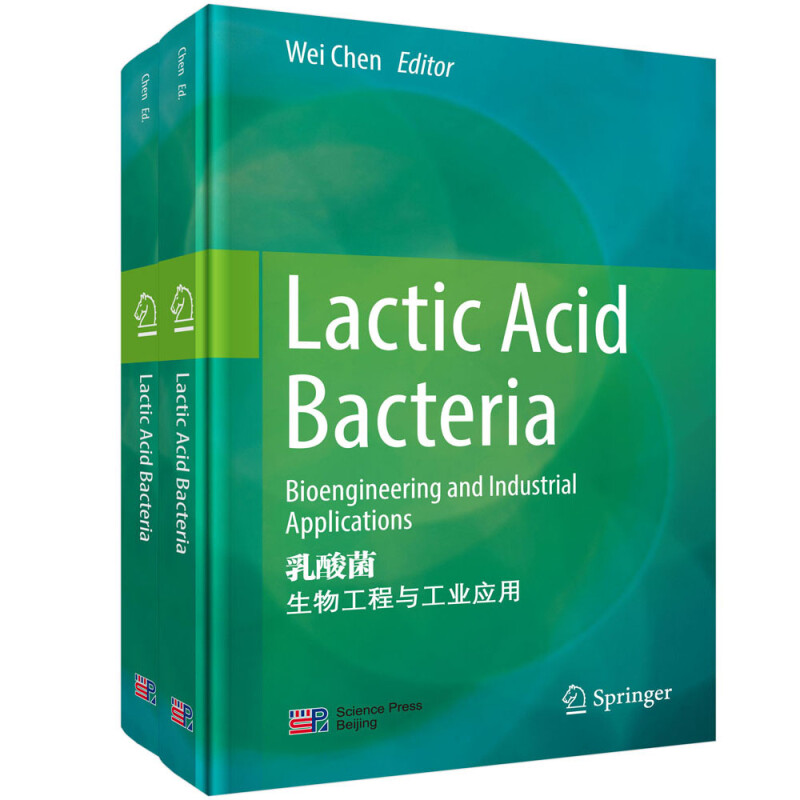
乳酸菌(组学与功能性评价,生物工程与工业应用)/英文版/共2卷

- ISBN:9787030691316
- 装帧:一般胶版纸
- 册数:暂无
- 重量:暂无
- 开本:B5
- 页数:720
- 出版时间:2022-06-01
- 条形码:9787030691316 ; 978-7-03-069131-6
内容简介
**卷介绍了乳酸菌领域的近期新研究和新技术,包括比较基因组学、转录组学、蛋白质组学和代谢组学等,并且针对乳酸菌的功能评价模型与研究历史展开了详细的介绍。此外,聚焦目前生命科学领域的研究热点,本书还介绍了乳酸菌与肠道健康和宿主免疫力之间的关系,乳酸菌的安全性评价体系和商业化的对健康有益的乳酸菌菌株。该书总结了乳酸菌在食品和健康方面的生物技术进展,这对于食品微生物学、生物工程、食品科学、营养和健康领域的研究人员和研究生将是有用的。第二卷重点介绍了乳酸菌生产的多种活性物质,主要包括γ-氨基丁酸、双乙酰、共轭脂肪酸、B族维生素、细菌素等,同时乳酸菌也可以用作发酵剂,在发酵谷物、果蔬、肉制品、医药领域和动物水产养殖等领域均得到广泛的应用。该书总结了乳酸菌在生物活性物质和发酵工业应用方面的生物技术进展,这对于食品微生物学、生物工程、食品科学、营养和健康领域的研究人员和研究生将是有用的。
目录
1 Lactic Acid Bacteria and γ-Aminobutyric Acid and Diacetyl 1
Shunhe Wang, Pei Chen, and Hui Dang
2 Lactic Acid Bacteria and Conjugated Fatty Acids 21
Wei Chen, Bo Yang, and Jianxin Zhao
3 Lactic Acid Bacteria and B Vitamins 45
Wanqiang Wu and Baixi Zhang
4 Lactic Acid Bacteria and Bacteriocins 67
Qiuxiang Zhang
5 Lactic Acid Bacteria Starter 101
Wei Chen and Feng Hang
6 Lactic Acid Bacteria and Fermented Cereals 155
Bowen Yan and Hao Zhang
7 Lactic Acid Bacteria and Fermented Fruits and Vegetables 191
Bingyong Mao and Shuang Yan
8 Lactic Acid Bacteria and Fermented Meat Products 221
Shumao Cui and Zhexin Fan
9 The Preparation Technology of Pharmaceutical Preparations of Lactic Acid Bacteria 237
Wei Chen and Linlin Wang
10 Lactic Acid Bacteria in Animal Breeding and Aquaculture 267
Gang Wang and Xing Jin
节选
Chapter 1 Lactic Acid Bacteria and γ-Aminobutyric Acid and Diacetyl Shunhe Wang, Pei Chen, and Hui Dang 1.1 Lactic Acid Bacteria and γ-Aminobutyric Acid 1.1.1 Introduction of γ-Aminobutyric Acid 1.1.1.1 γ-Aminobutyric Acid γ-Aminobutyric acid (GABA), or γ-ammonia butyric acid, is a kind of nonprotein amino acid which widely exists in vegetables and animals. It exists in the seeds, roots, and tissue fluid of many plants, such as Glycine L., Panax, herbal, and in animals almost exclusively present in nervous tissues. The content of GABA in brain tissue is 0.1–0.6 mg/g, and immunology research show that substantia nigra contain the highest concentration of GABA (Krajnc et al. 1996). Meanwhile GABA is also present in microorganisms, such as yeast, Lactobacillus, and Escherichia coli. GABA was discovered in the metabolite of plants and microorganisms in 1883. Awapara et al. (1950), Roberts and Frankel (1950), and Udenfriend (1950) found that the content of GABA was relatively high in the brain of mammals, but the biological significance was unknown. Roberts reported that GABA was a product of glutamate through α-decarboxylation. Krnjevi. and Schwartz (1966) researched that GABA played a part in the brain of mammals as an endogenous neurotransmitter and GABA was confirmed as an inhibitory neurotransmitter in the Second International Symposium on GABA in 1975. Many studies in recent years have reported the physiological function of GABA, including delaying senescence of nerve cells, lowering blood pressure, repairing the skin, treating mental illnesses, and regulating cardiac arrhythmia and hormone secretion (He et al. 2007). Scientists from all around the world studied the synthesis technology and its related product. GABA could be produced by chemical synthesis, plant enrichment, and microbiological fermentation. Sawai et al. (2001) researched that the content of GABA in tea could be enhanced through a variable anaerobic-aerobic process. Meanwhile, it also could be produced by controlling the germination condition of brown rice and rice germ. Xia Jiang et al. reported that Lactobacillus brevis CGMCCNO.1306 was isolated from unpasteurized raw milk and the capacity of GABA was 76.36 g/L after the mutation breeding (Xia 2006; Xia et al. 2006). 1.1.1.2 General Physicochemical Property The chemical formula is C4H9NO2 and molar mass is 103.120 g/mol. It appears as a white microcrystalline powder, easily soluble in water, slightly soluble in ethanol, and insoluble in cold ethanol, benzene, and ether. The dissociation constant of pKCOOH and pKNH3 is 4.03 and 10.56, respectively. GABA has no optical rotation, the melting point was 203–204℃. Its products of decomposition were pyrrolidone and water (Chen et al. 2010). In most part, GABA exists in the form of amidogen with positive charge or carboxyl with negative charge. The state of GABA determined its molecular conformation. In the gaseous state, the molecular conformation is highly folded due to the electrostatic interaction of two charged groups; in solid state, the molecular conformation is extended due to the intermolecular interaction between the two groups. When in liquid state, molecular conformations exist in both states. The various conformations of GABA are combined with different receptor proteins, which play significant physiological functions. 1.1.2 GABA Production of Lactic Acid Bacteria GABA In microorganisms GABA is produced from L-glutamate or its sodium salt by α-decarboxylation reaction at the catalysis of glutamate decarboxylase. Glutamate decarboxylase is the single enzyme to generate GABA from L-glutamate or its sodium salt, which was discovered in bacteria, archaea, and eucaryotic microbes. Compared with chemical synthesis and plant enrichment, GABA from microorganism fermentation, which has low cost and high yield, can be used in food safely. Lactic acid bacteria (LAB), as a safe microorganism (GRAS), are widely used in foods, such as yogurt, cheese, and pickles. Many studies show that LAB have glutamate decarboxylase which generates GABA from L-glutamate by decarboxylation reaction. Nomura et al. (1998) reported that the content of GABA was 383 mg/ kg in cheese, in which a strain of Lactococcus lactis 01–7 with high GABA was isolated. Komatsuzaki et al. (2005) researched that a strain of Lactobacillus paracasei NFRI7415 with high GABA was isolated from traditional fermented food and the capacity of GABA was 302 mmol/L. Xu et al. (2002) isolated a strain of Lactococcus lactis with high GABA for the first time interiorly, and the amount of GABA in the fermentation broth was 250 mg/100 ml, which was fermented in 25 L tank for 72 h. It could be used in the development of yogurt or as an ingredient in other foods. Cui et al. (2005) also reported the screening and fermentation conditions of high GABA-producing Lactobacillus, and the capacity of GABA was 5.4 g/L in the fermentation
-

勒维特之星-大发现系列丛书
¥4.0¥16.0 -

喜马拉雅山珍稀鸟类图鉴
¥27.2¥68.0 -

昆虫的生存之道
¥12.2¥38.0 -

昆虫采集制作及主要目科简易识别手册
¥15.0¥50.0 -

古文诗词中的地球与环境事件
¥8.7¥28.0 -

声音简史
¥21.3¥52.0 -

不匹配的一对:动物王国的性别文化
¥16.7¥42.8 -

物理学之美-插图珍藏版
¥20.7¥69.0 -

现代物理学的概念和理论
¥18.4¥68.0 -

技术史入门
¥14.4¥48.0 -

几何原本
¥35.6¥93.6 -

改变世界的发现
¥15.4¥48.0 -

图说相对论(32开平装)
¥13.8¥46.0 -

数学的魅力;初等数学概念演绎
¥7.7¥22.0 -

星空探奇
¥14.0¥39.0 -

宇宙与人
¥10.5¥35.0 -

数学专题讲座
¥13.3¥29.0 -

袁隆平口述自传
¥19.9¥51.0 -

为了人人晓得相对论
¥3.9¥13.5 -

一代神话:哥本哈根学派
¥8.1¥15.5











